HDMS Skjold was an armored coastal defense ship built for the Royal Danish Navy, a larger vessel than previous ones, but parliamentary opposed the funding and forced the navy to compromise. This vessel was designed for the defense of Copenhagen, small and of shallow draft, but heavily armed and protected still with a single 240 mm (9.4 in) gun and complete Harvey armor belt. Apart routine exercises from the late 1890s to the early 1910s and a few ports visits in the Baltic and northern Europe, Skjold enforced the Danish neutrality in World War I, guarding the capital, patrolling the Great Belt until decommissioned in December 1918 but still kept in reserve for another decade and sold for BU in 1929.
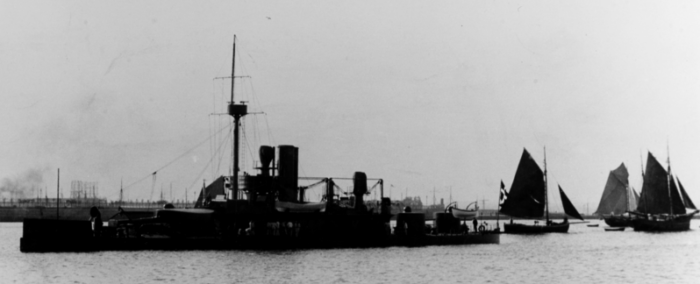
Development of the kystforsvarsskib HDMS Skjold
Denmark saw a decline from a major navy before the Battle of Copenhagen in 1801 to a minor one, bound to only coastal defence of its own waters by the 1890s. The only posture was to defend its own shore from the growing strength of its main neighbor, Imperial Germany. From the 1860s to 1880s, Denmark had five coastal defense ships and tried to use them inside an integrated coastal defense network. The linchpin was the island of Zealand and capital of Copenhagen. This network alo counted torpedo boats and coastal fortifications, as well as a plan to lay minefields in strategic locations in wartime. Skjold was the most important piece of this strategy as she was designed to guard the southern approach to Copenhagen and needed a shallow draft, in order to withdraw through the Kalveboderne, between Zealand and Amager in case of strong opposition, drawing the enemy into a maze of coastal batteries and counter-attacks by TBs.

By the 1880s, the Danish admiralty also realized the importance of protected cruiser seeing the Chilean cruiser Esmeralda in action. The shift was such as a faction of the Dansk marine even asked to stop building armored coastal defense ships. Their argment was that large guns had increased in power so much that conventional armor was defeated (this was not far from the Jeune Ecole conclusions in France by the way). As a result, this (rather young) faction obtained budgets for small protected cruisers: HDMS Hekla, Gejser, and Valkyrien, all lightly armored but heavily armed. However with the arrival of new types of armour the old guard ion the Navy prevailed again and asked in 1889 to stop funding cruisers and return to heavily protected and well armed coastal warships. Their point was that new nickel-steel alloys leading to the “Harvey” armor process made armour win over armament again.
Thus the same year in 1889, the navy requested funding for a new, larger armored coastal defense ship rated at the tome for 3,500 long tons (3,600 t). Design studies were ordered to the Orlogsværftet shipyard in Copenhagen. Several proposals were reviewed, and one retained, then submitted to the diet, the Danish parliament. However the latter rejected this request, still having many supporters of light cruisers, judged cheaper and more efficient. They only authorized instead to fund the cruiser Hejmdal.
The navy was advised to just made their project smaller, and asked Orlogsværftet new proposals. A new coastal defense ship was studied in 1890, was submitted, but the parliament rejected it again. The project was further refined, a bit smaller and cheaper, but the same pattern was repeated in 1891, to the despair of the new majority in the Admiralty. Meanwhile, Danish intel reported about the rapid rise of the Imperial German Navy and its construction of six coastal defense ships of the Siegfried class. They were all on papeer to guard the Elbe, but due to their shallow waters, they also could be used against Denmark and access Copenhagen.
Desperate, the admiralty this time did not wanted to delay construction further and revised its plans drastically, with proposals for a much smaller coastal defense ship. I went from a 3,500-ton ship to a 2000 tonnes ships, very compact, yet still well armed and armoured. Probably with a lot of arguing and arms twisting, the project was at last funded by the diet in mid-1892. On 2 September 1892, the navy requested Orlogsværftet detailed design drawings for the new construction. These plans were reviewed and approved on 15 May 1893. The new ship, named HDMS Skjold (“shield”), was laid down at last on January 1894. She was eventually launched on 8 May 1896 and Commissioned a year later on 25 May 1897.
Design of the class
Hull and general design
Skjold was buildt with a steel hull divided underwater into watertight compartments with a double bottom amidship, just below the ammunition magazines and machinery spaces. She was a midget coastal battleship at just 2,160 long tons (2,190 t) in displacement as designed, barely more than a small protect cruiser. She measured 69.24 m (227 ft 2 in) long between perpendiculars, 73.99 m (242 ft 9 in) long overall with a reinforced bow and ram. In beam she was 11.6 m (38 ft 1 in) so a ratio of 1/6, maximum draft of 4.16 m (13 ft 8 in). Given her proportions she could turn quickly in the confines of the waters she was to be posted, an essential advantage in hr role, as well as making her a stable weapon platform.
She had thus a low freeboard (barely better than a monitor) and relatively shallow draft, to keep her stability, superstructure was minimalistic with just a short upper deck structure, with a low open bridge on top of a small conning tower forward, and single tall funnel, two 900 mm (35 in) search lights on top of thick poles. She had two masts, one mainmast with spotting top forward of the CT, one aft close to the rear searchlight.
The central “island” with stacked everything made less than 1/3 of her overall lenght, freeing the forward and aft section. One peculiar aspect was her main turret forward, so low its muzzle barely cleared the prow’s bulwark. There was zero depression possible. The aft space grouped the three secondary guns in a triangle. Light guns were placed where possible alternated with four service boats. She had electric lighting throughout and steam central heating. Speaking tubes went from the open bridge to the gun crews and other parts of the vessel, such as the engine room. Her crew comprised 138 officers and enlisted men total.
Protection
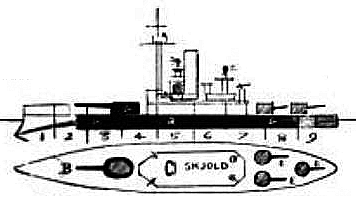 Skjold was very well protected still, with Harvey armor, the novelty of the time.
Skjold was very well protected still, with Harvey armor, the novelty of the time.
Belt armor: 175 to 225 mm (7 to 9 in) thick, entire length. Thickest portion amidships, magazines and propulsion, tapared down bow and stern, 0.94 m (3 ft 1 in) above, 1.1 m (3 ft 7 in) below the waterline, backed by 110 mm (4.3 in) teak, and then two layers of 11 mm (0.43 in) steel plating, inner skin to prevent shrapnel. What was off is that the belt was ordered to tow yards, the starboard side by French Schneider-Creusot, and port side by British Vickers, presumably to compare performances.
Armoured Deck: Central flat portion 19 mm (0.75 in) thick, backed by 32 mm (1.3 in) steel full length (no bulkheads). Bow and stern tapered down to 10 mm (0.39 in) on 26 mm (1.02 in) steel, attached to the top of the belt armor.
Main battery turret: It had flat sides in an ovale shape, these walls being 200 mm (7.9 in) thick, and doubled by two layers of 25 mm (0.98 in) steel inside. It ised a different nickel-steel alloy than the rest, less prone to cracking than standard Harvey steel, and more expensive (also applied to the conning tower). This came from Schneider-Creusot with a sloped roof made of two layers of armor plate, 19 mm atop 32 mm.
Secondary gun turrets: Ovale flat sided turrets, flat roof, with a small spotting casemate on top. 120 mm (4.7 in) of standard Harvey steel armor, faces and sides. Roofs made of two layers of 13 mm steel.
Conning tower: As said above, better alloy armor, 200 mm (7.9 in) thick with two 25 mm (50 mm) internal backing. It had an armored tube below with all communication from the open bridge passing through this tube with telegraph wires and speaking tubes as well as control cables from the helm.
Powerplant
Skjold had two triple-expansion steam engines which drove tow short shafts and 3-bladed screw propellers. This powerplant was manufactured locally at Burmeister & Wain. Each was located in its own separate, watertight engine room. Four water-tube, coal-fired Thornycroft type boilers built by Orlogsværftet provided the steam, located in twop separate rooms, were vented through a single, tall funnel. The boiler used forced draft and there was a small auxiliary boiler in the conning tower, used just for heating when the engine was cold, and feed electricity to some systems. Skjold was the first Danish ship using Thornycroft tyoe small tubes boilers, after the small cruiser HDMS Gejser, rated for 2,400 indicated horsepower (1,800 kW) total. This made for a contracted top speed of 14 knots (26 km/h; 16 mph). 109 long tons (111 t) of coal were provided so she was short ranged, probably around 1200 nm (figure unknown).
Armament
With such as short hull, there was hardly more room for anything else but a single heavy gun and just three secondaries, and four light guns for close defence, no torpedo tubes. Compared to the three 24 cm of the Siegfried class still, but Skjold had a slightly better protection at 228 mm (9 in) for the main belt, 254 mm (10 in) for the turret, versus 230-203 mm.
1x 240 mm (9.4 in) Krupp SK L/37 M1893
Her main battery was a single 240 mm (9.4 in) SK 40, 40 caliber gun. It was manufactured by Krupp and placed forward with both the turret and mechanisms provided by Canet in France. The innovation there was that this was the first balanced turret of the Danish Navy. Before that, stability problems casued the ship to lost heavily when traversing full broadside. Inside the turrey, the ammunition hoist was electrically powered for elecation, but training was hydraulic and manual. Thus gun was capable of a range of 9,800 m (32,200 ft), but only fired a shot every two minutes. The storage ws limited to just fifty armor-piercing (AP) shells, using smokeless powder charges. Loading was only possible at a fixed 2 degrees elevation angle.
3x 120 mm (4.7 in) Krupp SK L/40 C/92
The secondary battery aft comprised three 120 mm (4.7 in) Krupp guns, mounted in individual gun Canet turrets in a triangle pattern, two either side close to the suprestructure tail and a single one in the axis aft, close to the prow. Like the main turret, they used electrical gun laying electric motors with manual training and loading. Their range was inferior, to 7,300 m (24,000 ft) but they were mch faster at five shots per minute, supplied with 240 shells total for all three.
4x Hotchkiss 3-pdr
For close-range defence, Skjold had four 3-pounder guns, and a single 1-pounder Hotchkiss revolver cannon, all of the 47mm/40 Model 1885 from France. Two were located forward on the triangular structure behind the main turret and two aft, same.
⚙ specifications Skjold |
|
| Displacement | 2,160 long tons (2,190 t) |
| Dimensions | 69.24 x 11.6 x 4.16m (227 ft 2 in x 38 ft 1 in x 13 ft 8 in) |
| Propulsion | 2× shafts VTE, 4× Thornycroft boilers 2,400 ihp (1,800 kW) |
| Speed | 14 knots (26 km/h; 16 mph) |
| Range | |
| Armament | 1× 240 mm, 3× 120 mm, 4× 3-pdr, 1× Hotchkiss revolver. |
| Protection | Belt 178 to 228 mm, Deck 51 mm, Gun turret 254 mm |
| Crew | 138 |
Career of HDMS Skjold

Construction was authorized under the 1893–1894 naval budget and she was laid down at Orlogsværftet in January 1894, launched on 8 May 1896, completed in 1897, commissioned on 25 May. After her first year of initial trauning and sjakedown, fixes, she entered a routine of annual summer training maneuvers, in Danish waters, and combined with the rest of the active squadron. They all started in June or July and ended in September-October. Sometimes they included also visits abroad. She onced cruised to the Bothnian Sea (Baltic). In normal operation she had a smaller crew and was less expensive to operate, and each year, the time she was not in manouver saw two months of maintenance and the crew was on leave and back to its land activities, apart the officers.
By May 1897 she made a first trip to the Skaggerak and stopped in Oslo, Norway during her sea trials until June. She took part in the summer training exercises of 1898 and 1901 with training cruises of the active squadron, to Riga (Russian Empire) the first time, and Gävle in Sweden for the 1901 maneuvers. She was decommissioned on 28 September, then reactivated for weapons testing with new HE shells used on the old gunboat Møen as target. These 100 mm (3.9 in) guns used for the tests were remotely fired from Skjold. Three shots ended the career of Møen, presumably one exploding in her main gun casemate and magazine.
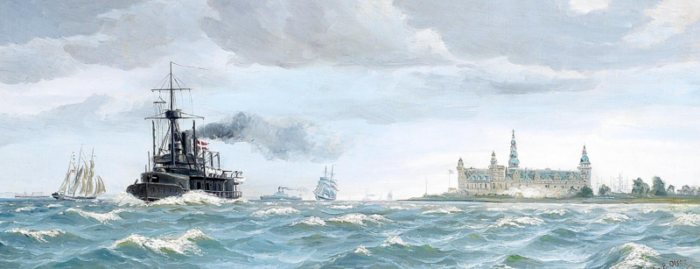
Skjold in 1901 with her initial dark grey paint.
Next were summer training squadrons for 1902, 1904, 1905, and 1906 with visits to Kiel. She was in maintenance and refit in 1907 but took part in the 1908 training squadron. In 1909, she was for the first time used for winter training exercises in addition to the summer. This was due to the vote of the Navy Act of 1909, to increase naval readiness of the Danish fleet. Skjold was left in maintenance in 1910 but took part on the 1911–1912 summer and winter training sessions, notably alongside the new coastal defense ship Peder Skram and torpedo boats, minesweepers, training for extensive defensive operations. She took part in the 1912 summer squadron, and winter 1912–1913, teaming with HDMS Olfert Fischer.
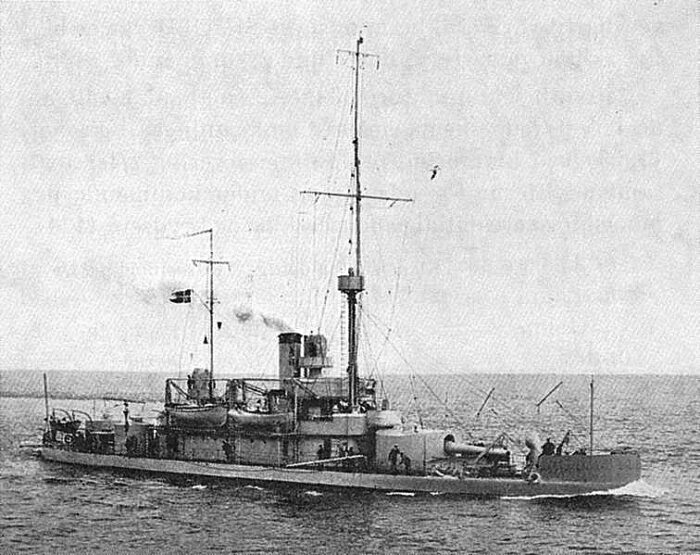
Skjold in 1912
When World War I broke out in August 1914, Denmark choose widely to remain neutral, and Skjold was laid upat the time, but with the creation of the Sikringsstyrken (security force), copprising the three Herluf Trolle-class ships initially, Skjold was soon reactivated with a full crew to assist. On 5 August she was recommissioned, placed in the reserve force, attached to the 1st Squadron. This reserve force alone also comprised three cruisers, four gunboats, eight torpedo boats, fifteen patrol boats and it was son prepared and redesignated the 2nd Squadron. The 1st Squadron was sent to patrol the Øresund and northern approaches to Copenhagen, and the 2nd Squadron, the Great Belt and southern approaches. Skjold and the three Herluf Trolle-class alternated between both Squadrons. On 22 November 1917, Skjold assisted a running agrojnd schooner west of Stubbekøbing, Falster island. She was detached in the winter of 1917–1918 for a training cruise in Danish waters, alternating between local ports. On 22 December 1918 she returned in the reserve.
In the 1920s, with an evern tighter naval budget Skjold remained in reserve. There were discussion to disarm her and reuse her artillery on the coastal defenses of the islands of Falster and Møn. However later it was rather more judivious to have her moored to the shore in the Grønsund, enabling the transport of her three 120 mm guns to the coastal fortifications here. She stayed moored at the Holmen Naval Base in Copenhagen until stricken from the naval register on 21 May 1929 and sold for BU.
Read More/Src
Books
Anderson, R. C., ed. (1914). The Naval Pocket-Book. London: W. Thacker & Co.
Brassey, Thomas A., ed. (1896). “Part III: Chapter II: Ordnance”. The Naval Annual. Portsmouth.
Campbell, N. J. M. (1979). “Denmark”. Gardiner, Robert; Chesneau, Roger. Conway’s All the World’s Fighting Ships 1860–1905.
Dunell, G. R. (1897). Brassey, Thomas A. (ed.). “Marine Engineering”. The Naval Annual
Hovgaard, William (1920). Modern History of Warships. London: E. & F. N. Spon, Ltd.
Parkes, Oscar; Prendergast, Maurice, eds. (1920). “(Royal) Danish Navy”. Jane’s Fighting Ships.
Steensen, Robert Steen (2018) [1968]. Vore Panserskibe 1863–1943. Copenhagen: Strube.
Westerlund, Karl-Erik (1986). “Denmark”. Gardiner, Robert & Gray. Conway’s All the World’s Fighting Ships 1906–1921.
Wismann, Tom (2018). “The Coastal Battleship Peder Skram (1908)”. The World of the Battleship 1880–1990. Barnsley.
Weyl, E. (1894). Brassey, Thomas A. (ed.). “Progress of Foreign Navies”. The Naval Annual. Portsmouth.
Links
navypedia.org/ skjold.htm
on da.wikipedia.org/ Skjold_(kystforsvarsskib)
en.wikipedia.org/ HDMS_Skjold_(1896)
Videos
Model Kits
3D
HDMS Skjold by martyn169 on Sketchfab

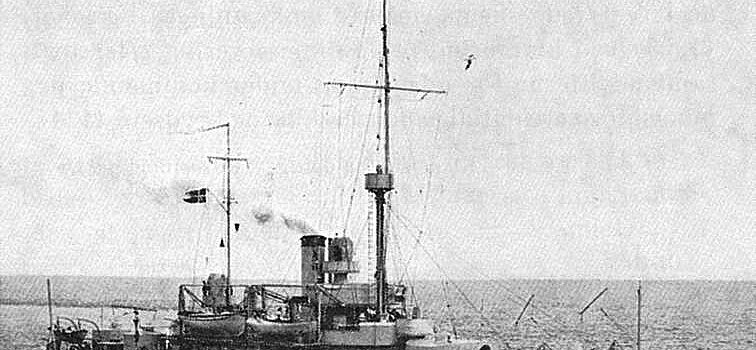

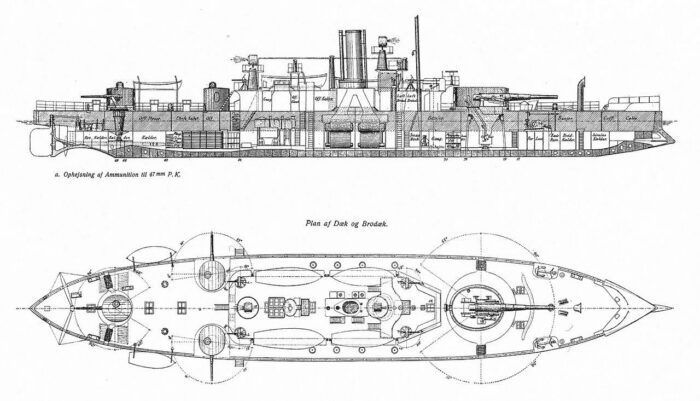
 Latest Facebook Entry -
Latest Facebook Entry -  X(Tweeter) Naval Encyclopedia's deck archive
X(Tweeter) Naval Encyclopedia's deck archive Instagram (@navalencyc)
Instagram (@navalencyc)





 French Navy
French Navy Royal Navy
Royal Navy Russian Navy
Russian Navy Armada Espanola
Armada Espanola Austrian Navy
Austrian Navy K.u.K. Kriegsmarine
K.u.K. Kriegsmarine Dansk Marine
Dansk Marine Nautiko Hellenon
Nautiko Hellenon Koninklije Marine 1870
Koninklije Marine 1870 Marinha do Brasil
Marinha do Brasil Osmanlı Donanması
Osmanlı Donanması Marina Do Peru
Marina Do Peru Marinha do Portugal
Marinha do Portugal Regia Marina 1870
Regia Marina 1870 Nihhon Kaigun 1870
Nihhon Kaigun 1870 Preußische Marine 1870
Preußische Marine 1870 Russkiy Flot 1870
Russkiy Flot 1870 Svenska marinen
Svenska marinen Søværnet
Søværnet Union Navy
Union Navy Confederate Navy
Confederate Navy Armada de Argentina
Armada de Argentina Imperial Chinese Navy
Imperial Chinese Navy Marinha do Portugal
Marinha do Portugal Mexico
Mexico Kaiserliche Marine
Kaiserliche Marine 1898 US Navy
1898 US Navy Sovietskiy Flot
Sovietskiy Flot Royal Canadian Navy
Royal Canadian Navy Royal Australian Navy
Royal Australian Navy RNZN Fleet
RNZN Fleet Chinese Navy 1937
Chinese Navy 1937 Kriegsmarine
Kriegsmarine Chilean Navy
Chilean Navy Danish Navy
Danish Navy Finnish Navy
Finnish Navy Hellenic Navy
Hellenic Navy Polish Navy
Polish Navy Romanian Navy
Romanian Navy Turkish Navy
Turkish Navy Royal Yugoslav Navy
Royal Yugoslav Navy Royal Thai Navy
Royal Thai Navy Minor Navies
Minor Navies Albania
Albania Austria
Austria Belgium
Belgium Columbia
Columbia Costa Rica
Costa Rica Cuba
Cuba Czechoslovakia
Czechoslovakia Dominican Republic
Dominican Republic Haiti
Haiti Hungary
Hungary Honduras
Honduras Estonia
Estonia Iceland
Iceland Eire
Eire Equador
Equador Iran
Iran Iraq
Iraq Latvia
Latvia Liberia
Liberia Lithuania
Lithuania Mandchukuo
Mandchukuo Morocco
Morocco Nicaragua
Nicaragua Persia
Persia San Salvador
San Salvador Sarawak
Sarawak Uruguay
Uruguay Venezuela
Venezuela Zanzibar
Zanzibar Warsaw Pact Navies
Warsaw Pact Navies Bulgaria
Bulgaria Hungary
Hungary

 Bundesmarine
Bundesmarine Dutch Navy
Dutch Navy Hellenic Navy
Hellenic Navy Marina Militare
Marina Militare Yugoslav Navy
Yugoslav Navy Chinese Navy
Chinese Navy Indian Navy
Indian Navy Indonesian Navy
Indonesian Navy JMSDF
JMSDF North Korean Navy
North Korean Navy Pakistani Navy
Pakistani Navy Philippines Navy
Philippines Navy ROKN
ROKN Rep. of Singapore Navy
Rep. of Singapore Navy Taiwanese Navy
Taiwanese Navy IDF Navy
IDF Navy Saudi Navy
Saudi Navy Royal New Zealand Navy
Royal New Zealand Navy Egyptian Navy
Egyptian Navy South African Navy
South African Navy






























 Ukrainian Navy
Ukrainian Navy dbodesign
dbodesign